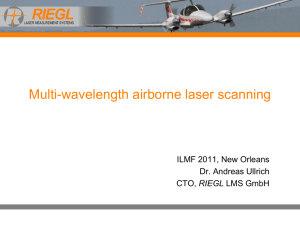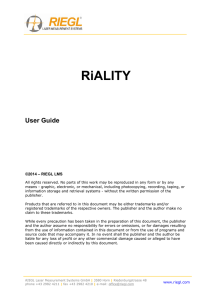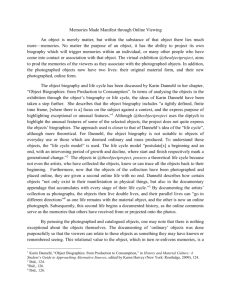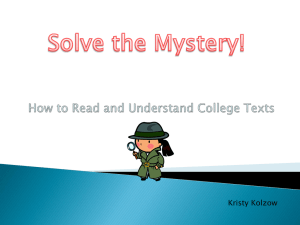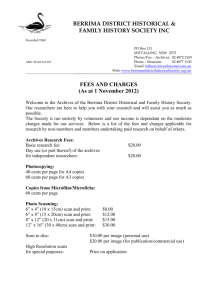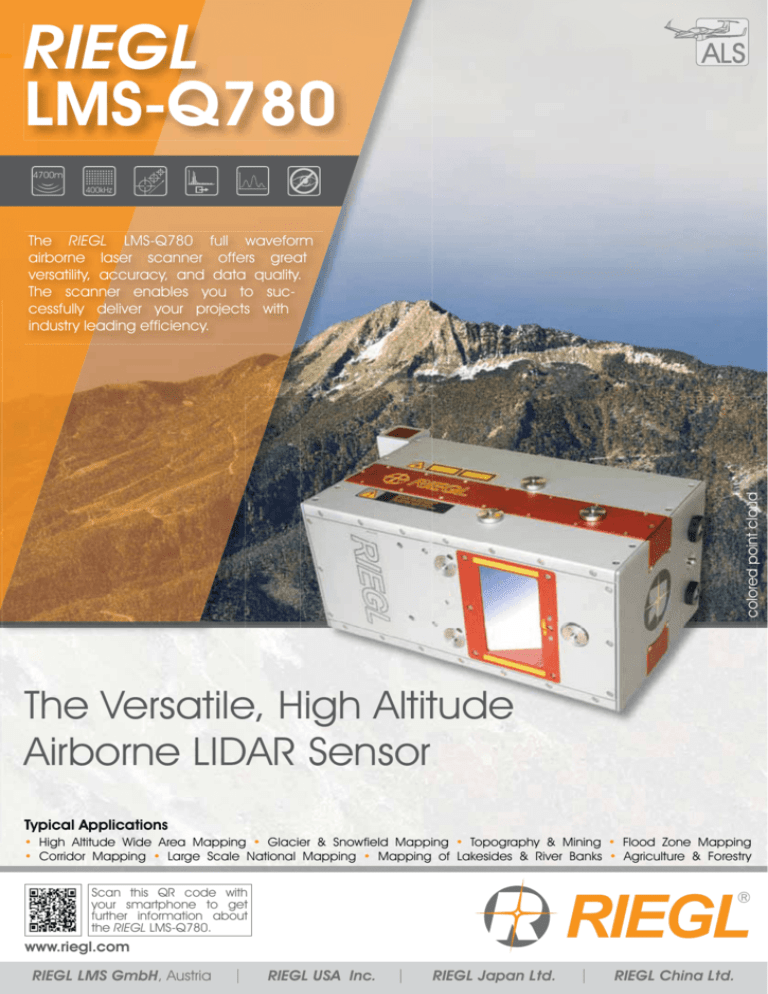
RIEGL
LMS-Q780
4700m
400kHz
colored point cloud
The RIEGL LMS-Q780 full waveform
airborne laser scanner offers great
versatility, accuracy, and data quality.
The scanner enables you to successfully deliver your projects with
industry leading efficiency.
The Versatile, High Altitude
Airborne LIDAR Sensor
Typical Applications
• High Altitude Wide Area Mapping • Glacier & Snowfield Mapping • Topography & Mining • Flood Zone Mapping
• Corridor Mapping • Large Scale National Mapping • Mapping of Lakesides & River Banks • Agriculture & Forestry
Scan this QR code with
your smartphone to get
further information about
the RIEGL LMS-Q780.
www.riegl.com
RIEGL LMS GmbH, Austria
RIEGL USA Inc.
RIEGL Japan Ltd.
RIEGL China Ltd.
One Versatile LIDAR Sensor –
Executive Summary
RIEGL LMS-Q780
Take off with the RIEGL LMS-Q780!
The RIEGL LMS-Q780 is the versatile high altitude airborne LIDAR sensor for
all projects: from corridor to wide-area, and large-scale national mapping.
RIEGL delivers unrivaled efficiency at low operating costs.
Highlights
The RIEGL LMS-Q780, with up to 10 simultaneous pulses in the air,
results in the most effective spacing on the ground. This eliminates the
need of terrain following while retaining a high effective rate. Industry
leading digital signal processing, combined with the comprehensive
RIEGL software suite, delivers high-quality LIDAR data.
Others
RIE
GL
The RIEGL LMS-Q780 delivers straight parallel scan lines and more
equally spaced laser footprints on the ground. Even small objects can
be detected by the high-resolution Matrix Scan Pattern.
FOV
60°
The RIEGL LMS-Q780, operated at up to 15,500 feet above ground
with its full Field of View of 60 degrees, provides both a wide effective
swath width and a narrow point spacing simultaneously. This minimizes
operating costs.
The RIEGL LMS-Q780 digital full waveform sensor provides access to
detailed target characteristics by digitizing the echo signal online during
data acquisition and subsequent full waveform analysis.
The instrument is ideally suited for tightly coupled GNSS/IMU integration
for acquiring position and orientation of the platform within a global
coordinate system.
Conclusions
• Great versatility, accuracy and data quality
• Up to 10 pulses in the air handled simultaneously, offering industry leading digital signal processing
• The RIEGL LMS-Q780 delivers perfectly straight parallel and high resolution scan lines described as Matrix Scan Pattern
• With a very wide effective swath width, the RIEGL LMS-Q780 delivers unrivaled operating efficiency
• Applicable from high altitude wide area mapping to low flight altitude corridor mapping
The RIEGL LMS-Q780 is your versatile airborne sensor solution!
page 2 of 6
RIEGL LMS-Q780
Leading Technology in ALS
Leading Technology in Airborne Scanning
• Rotating Polygon Mirror - resulting in straight, parallel scan lines on the ground
• RiSOFTWARE - complete data acquisition and processing software suite for airborne mapping
• Reliability - trust in the high quality of RIEGL products and software solutions
Rotating Polygon Mirror
The clear advantage of polygon mirrors compared to other
currently used techniques on the market is the continuous and
smooth rotation of the mirror which leads to straight parallel scan
lines on the ground. The achievable scan rates are high and
allow flexible adjustment for obtaining an even distribution of
points on the ground. Furthermore low vibrations and low stress on
the deflecting mirror surfaces and the scan mechanism maintain
constant and replicable measurement accuracy and reliability.
RiSOFTWARE
RiACQUIRE
• Project-oriented scan data acquisition and scanner control
• Online visualization of geo-referenced monitoring data during acquisition
• Quality assurance with detailed history of events, system parameters and operator‘s interactions
• Status feedback for fast recognition by the operator
• 3D visualization
• Simplifies the acquisition process effectively
RiPROCESS
• Project-oriented scan data software for managing and processing RIEGL ALS and MLS data
• Operation in a multiple-workstation environment, parallel task processing
• Fast access to data for inspection in different visualization formats
• System calibration and scan data adjustment
• Statistical analysis of referencing, matching quality
• Interfacing to third party software packages
• Resulting in a very high quality geo-referenced point cloud
RiMTA – handling multiple pulses in the air, simultaneously!
• Automatic resolution of range ambiguity in time-of-flight ranging
• Unlimited number of MTA zones
• Smoothly integrated in the RIEGL data processing workflow
• No terrain following required
MTA 3
MTA 1
MTA 2
Reliability
Our customers rely on the RIEGL LMS-Q780 to work smoothly in demanding environments. The overall
system design and quality of manufacturing provides the legendary RIEGL reliability.
page 3 of 6
RIEGL LMS-Q780
Scan Performance
Scan Performance - Maximum Operating Efficiency
• Matrix Scan Pattern - stands for equally spaced laser footprints on the ground
• Wide Effective Swath Width - results in a very low number of necessary flight lines
Matrix Scan Pattern
flight direction
across spacing
along spacing
scan line
RIEGL LMS-Q780
point distribution
FOV
60°
Others
RIE
Wide Effective Swath Width
GL
The RIEGL LMS-Q780 scanner delivers straight parallel scan lines and an equally dense laser footprint
pattern on the ground. Even small objects may be detected by the high resolution Matrix Scan Pattern.
The parameters “across spacing” and “along spacing” refer to the point distance within a scan
line and between the scan lines, respectively. The shorter the maximum distance between
measurements on the ground, the better small objects are detected.
Small distances result in high sampling quality, which is enabled by RIEGL‘s Matrix Scan Pattern.
The broad swath width of the RIEGL LMS-Q780 results in a low number of necessary flight lines for surveying a
designated area. It takes about twice the number of flight lines to survey the same area with other instruments
on the market, because the user is forced to apply a quite narrow FOV and hence to fly for considerably longer
time. A side effect of this is that with a smaller swath also the straightness of the lines is more critical in order to
provide sufficient overlap which poses higher demands on the pilots or requires the use of stabilized platforms.
The RIEGL LMS-Q780 offers
a wide effective swath width
from different altitudes.
The necessary flight lines for
surveying a designated area
are reduced to a minimum.
The acquisition time to cover a certain area of 10 km x 10 km with at least 4 measurements per
square meter, will take with the RIEGL LMS-Q780 only a shade more than one hour.
The RIEGL LMS-Q780 offers outstanding operating efficiency.
page 4 of 6
Innovation in 3D
Colored Point Cloud
Ötscher, Austria, 2012
Acquisition Parameters:
Scanner: RIEGL LMS-Q780
Data Recorder: DR680
Field of View: 60°
PRR: 400 kHz
Scan Area: 57 km²
Scan Points: 716 million
Scan Time: 0:27 h
Average Point Density:
13 points/m²
Flight Parameter:
997 m - 2420 m AGL
(3000 m above MSL)
110 knots
Flight Time: 0:45 h
RIEGL Laser Measurement Systems GmbH assumes no responsibility or liability what so ever
regarding the correctness, appropriateness, completeness, up-to-dateness, and quality
content and for the accuracy of the depicted objects respectively. All rights reserved.
© Copyright RIEGL Laser Measurement Systems GmbH, Horn, Austria.
www.riegl.com
page 5 of 6
Brochure, RIEGL LMS-Q780, 2015-03-17
RIEGL LMS-Q780
Key Facts
Key Facts
• Technical Data
• Main Features
• Complete Data Acquisition & Processing Software Suite
Technical Data
4700m
max. operating flight
altitude AGL
400kHz
full waveform analysis
pulse repetition rate PRR
(peak)
waveform data output
multiple target capability
not intrinsically eye safe
Eye Safety Class
Laser Class 3B*
Max. Range Target Reflectivity 60%
5800 m
Max. Range Target Reflectivity 20%
4100 m
Minimum Range
50 m
Accuracy
20 mm
Effective Measurement Rate
up to 266 000 meas./sec
Field of View (FOV)
up to 60°
Max. Operating Flight Altitude AGL
4700 m / 15,500 ft
*Class 3B Laser Product according to IEC60825-1:2007
Main Features
• up to 266 000 measurements/sec on the ground
• operating flight altitude up to 15,500 ft AGL
• multiple time around processing: up to 10 pulses (MTA 10)
simultaneously in the air
• full waveform analysis for unlimited number of target echoes
• high laser pulse repetition rate up to 400 kHz
• high ranging accuracy up to 20 mm
• wide scan field of view up to 60°
• suited for measuring snowy and icy terrain
Complete Data Acquisition & Processing Software Suite
• RiACQUIRE
• RiANALYZE
• RiWORLD
RIEGL LMS-Q780
Datasheet
RIEGL LMS-Q780
White Paper
• RiPROCESS
• RiMTA ALS
RiACQUIRE
ALS Software
RiPROCESS
ALS Software
RiMTA ALS
ALS Software
Watch our videos!
youtube.com/riegllms
Visit our website to read the datasheets, white paper, and get further information,
also about the broad RIEGL product line.
www.riegl.com
page 6 of 6

